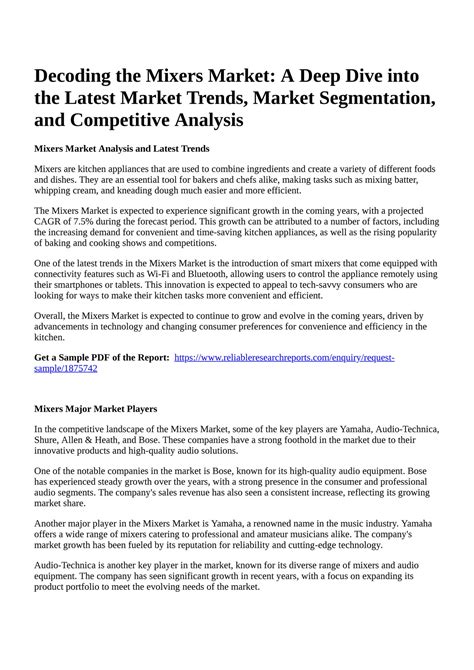Mixers: A Deep Dive into Their Functionality and Risks
In the world of cooking, mixers are a key tool for achieving consistency and quality across a variety of culinary applications. From whipping cream to blending sauces, mixers play a key role in bringing out the best flavors and textures in a variety of dishes. However, like any powerful piece of equipment, mixers also come with their own set of risks if not used correctly.
What is a Mixer?
A mixer is an electric or hand-held device designed to combine ingredients, often with minimal effort. The most popular types of mixers are stand mixers, hand mixers, and stick blenders. Each type has its own unique features and benefits, adapting to specific culinary tasks and user preferences.
Mixer Functionality

Mixers perform a variety of functions, including:
- Beating: Mixing ingredients until they reach the desired consistency, usually in the case of whipped cream or egg whites.
- Mixing: Combining ingredients into a smooth mixture, such as soups, sauces, or dressings.
- Blending: Combining dry and wet ingredients, such as dough.
- Chop: Grinding ingredients into smaller particles, commonly used in coffee machines.
Mixer Hazards
Mixers are an essential tool for many home cooks, but they also pose several hazards if not used correctly. Some of the most serious hazards include:
- Electric shock: Stand mixers and hand blenders often contain moving parts that can cause electrical shocks if not handled correctly.
- Slippery surfaces: The wet environment created when mixing ingredients can lead to slips and falls, especially in kitchens with inadequate lighting or flooring.
- Overheating: Mixers can overheat if overloaded, which can damage the equipment and create a fire hazard.
- Eye Injury: Mixing hot mixtures without proper eye protection can result in serious injury.
Precautions to Avoid Mixer Hazards
To minimize the risks associated with mixers, follow these safety guidelines:
- Read Instructions Carefully: Before using the mixer, read and understand its functions, operating instructions, and recommended uses.
- Handle Mixes Carefully: Always handle hot mixtures and sharp objects with care to avoid burns and eye injuries.
- Keep Areas Clean and Tidy: Ensure that the mixing area is free of clutter and tripping hazards to reduce the risk of accidents.
- Follow Manufacturer’s Guidelines: Follow the manufacturer’s guidelines for loading, operating, and maintaining the mixer.
- Take Regular Breaks: Take regular breaks when using a mixer to give your hands and eyes a rest.
Types of Mixers: Choosing the Right One for Your Needs
When choosing a mixer, consider the following factors:
- Power Source: Electric mixers are typically more powerful than hand mixers, but they can be heavier and more expensive.
- Size and Capacity: Choose a mixer that can handle the amount of ingredients you typically use.
- Features: Consider the features that are most important to you, such as programmable timers or auto shut-off.
Conclusion
Mixers are an essential tool in many kitchens, but their functionality and risks cannot be ignored. By understanding the different types of mixers, their functions, and the potential hazards, cooks can take steps to minimize these risks and enjoy safe and efficient cooking. Always follow safety precautions, read instructions carefully, and choose a mixer that suits your needs.
Recommended Mixers for Beginners
If you’re new to mixing, consider starting with a beginner-friendly electric mixer or a hand mixer.


Geef een reactie